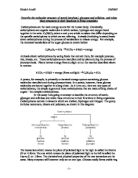Starch is the major storage molecule in plants. Plants make glucose predominantly in their leaf cells and starch is the most compact way of storing this sugar. It is insoluble, so preventing it from moving out of the cells it is stored in and into others and also making it strong and not involved in most chemical reactions because most take place in liquid. Starch is unique among polysaccharides because it occurs naturally in grains, which are found in amyloplasts, which are present in the cytoplasm of plant cells.
Glycogen is also a polysaccharide made up of the monomer alpha-glucose and is very similar to amylopectin. It has both 1,4 and 1,6 glycosidic bonds, short chains and is a very branched molecule, with the branches occurring every 8 – 12 residues, therefore forming a very compact structure.
Glycogen, like starch, is an energy storage molecule but it is found in animals. It occurs in the liver cells and muscle tissue where it is compact and can be readily hydrolysed to glucose for use as a respiratory substrate. It also prevents too high a concentration of glucose in the cells.
Cellulose is a polymer of beta-glucose monomers joined by 1,4 glycosidic bonds and has straight unbranched chains with no tendency to form a helical shape. The hydrogen bonding between the chains forms cross links, which make the polysaccharide very strong, and prevents access from water so that cellulose is very resistant to hydrolysis and is a good structural component. The chains can be held together, up to 2000 at a time, to form a microfibril.
The tensile strength of cellulose, which enables it to resist pulling forces, makes an important structural component in cell walls. The microfibrils are embedded in a matrix, which is a mixture of pectins and hemicelluloses. Cellulose is very difficult to digest and very few animals make the enzyme cellulase, which allows the cellulose to be broken down into glucose. Some animals have to depend on cellulose-digesting bacteria to break the polysaccharide down to release the important nutrients.








